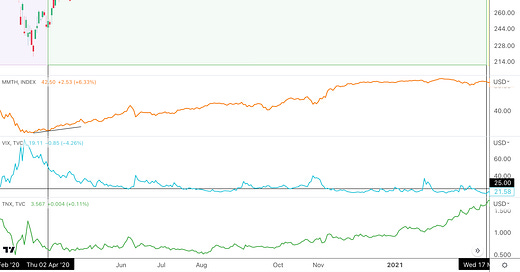Quick Note: Match Your Investment Strategy Mode to Market Conditions
I believe that there are three investment strategy modes for investors who seek to make money when market conditions are positive and protect capital when the market is dangerous. This is a way that I adjust my portfolio management strategy to the current market conditions:
Alpha Mode: Buy and hold strategy to maximize returns:
When to Implement – After a correction; when the Fed introduces an Inflationary (Dovish) Policy; stock valuations are low; the VIX is on a downtrend and the market bottoms with a higher low and higher high.
How to Know – Breadth indicators (% of Stocks Above the 200-day Moving Average) rise; interest rates fall; sentiment is very negative; the economy is in a recession and volume shows institutional buying.
When to Avoid – When the market is overvalued; when breadth is high & declining; when the Fed has a Deflationary (Hawkish) Policy and when inflation is high.
What to Do – Increase equity allocation; invest in growth; create a basket of stocks; buy relative strength; and buy breakouts.
After the Covid drop in March 2020, the Fed supported the market with a Dovish policy, as breadth (MMTH) rose and the VIX started a downtrend. Price action made a higher low, which was an excellent time to get into Alpha Mode and add equity exposure for years to come.
Beta Mode: Use trend-following and seasonal Investing to invest when the odds are stacked in your favor:
When to Implement – When the Fed is still Dovish; the VIX is below 25 and the market is up-trending but has a high P/E Ratio.
How to Know – S&P 500 is trending over the 200-day moving average as breadth declines, the current P/E ratio of the S&P 500 is over 20x and declining, while individual stocks begin rolling over.
When to Avoid – When the market is in a downtrend.
What to Do – Get out of individual stocks and invest in diversified funds. Take on more equity exposure before the start of strong seasonal periods. Reduce equity exposure before weak months. Use a trend-following system for risk management (set stop-loss orders) or invest in defined-risk options strategies.
In March 2021 breadth (MMTH) made a lower low from a high level. This began a death grind lower for individual stocks, namely growth stocks, even as the S&P 500 marched higher. This was the time to get into Beta Mode, sell individual stocks, and buy the index. Stop-loss orders could have been set at the 200-day SMA (shown below) or the 50-day SMA (not shown). Seasonality could have been used for the October 2021 rally.
Protection Mode: When the market is vicious, use techniques to protect your capital and wait for conditions to change.
When to Implement – When inflation is high; the Fed has a Contractionary (Hawkish Policy); interest rates rise; the market P/E ratio is over 20x and declining.
How to Know - The percentage of Nasdaq Stocks over 200ma is falling; margin debt is high and declining; individual stocks are falling hard; the S&P 500 is below 200-day moving average; rising interest rates drop high P/E growth stocks and the VIX is above 25.
When to Avoid – When you are doing the other 2 strategies
What to Do – Either take a very long-term horizon with downside protection or take a very short-term approach and day trade. Cherrypick portfolios by selling investments no longer deemed attractive. Raise cash. Perhaps buy portfolio protection (puts).
In January 2022 Fed Chair Powell made his intention to fight inflation through a contractionary Hawkish policy clear. This made the VIX spike over 25 as the market began to break down through the 200-day moving average. Good reasons to get into Protection Mode. Seasonality could have been used for the Summer rally and the Winter rally. Holding portfolio puts or having a cash cushion would have made investors sleep better at night. For those with the skill, day trading could have been lucrative as well.
How About Now? Breadth is up-trending, while the VIX is below 25 and downtrending. Interest rates are weakening. Unfortunately, the S&P 500’s Forward P/E Ratio is still high near 17.7x, as earnings are expected to stagnate. Moreover, inflation is still high around 6%. Finally, there is a mini-banking crisis, which appears to be contained for now. Due to these factors, I believe that we are currently back in a modified Beta Mode. This time around, stock-picking in sectors that have been beaten down could be a viable strategy, as technology and communications have led this year. It is key to be risk-focused and to be ready to re-enter Protection Mode if conditions worsen.
1 Source: Yardeni.com
How could Cycles help us through the different modes? Here is the Cycles Composite over the same time period:
You could see in the Cycles chart above that the Cycles Composite gave an early warning for many of the downdrafts that the market suffered in the past few years. Subscribe to see what the cycles are predicting next.









